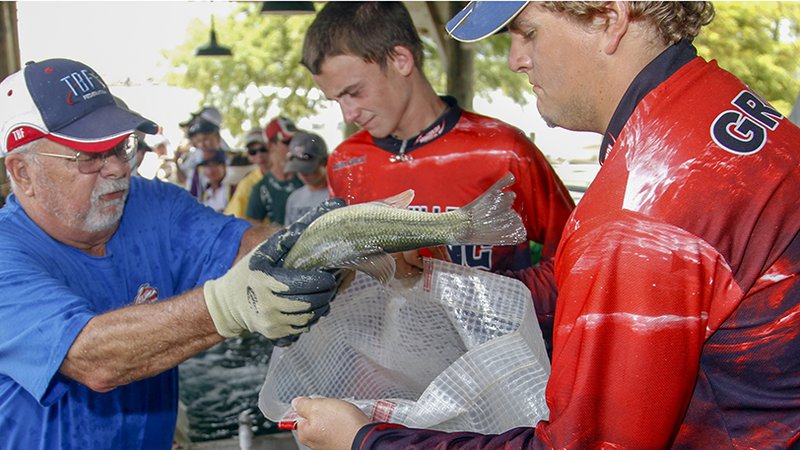Tournament anglers tell all through ATIP
ON 03-06-2019

March 6, 2019
Randy Zellers
Assistant Chief of Communications
HOT SPRINGS — No group plays their cards as close to their vests as bass tournament anglers. They may be all smiles and wish you the best at the boat ramp, but you’d have better luck getting Coca-Cola’s secret formula than getting the details on how they’re catching their fish. Thanks to the Arkansas Tournament Information Program, you can at least know how each lake those anglers are visiting stacks up with others in the state.
ATIP is a product of the Arkansas Game and Fish Commission’s Black Bass Program, which began in the early 2000s to give additional focus to the black bass species found in The Natural State.
“Largemouth, smallmouth and spotted bass are so popular with Arkansas anglers that we devote two full-time biologists solely to black bass management,” said Ben Batten, Fisheries Division chief for the AGFC. “That’s in addition to the two dozen or so regional fisheries supervisors and fisheries biologists that manage for bass as part of their normal duties improving lakes and rivers on a local level.”
Batten says other species, such as crappie, catfish and even alligator gar, have teams of regional biologists who split some of their time to work on monitoring and improving those species populations, but bass and trout are the only fish that receive this full-time assistance in addition to the regional efforts.
In addition to habitat work, population monitoring, genetics research, and recommendations on regulation changes and stocking, the Black Bass Program works directly with bass clubs to help promote bass fishing in Arkansas. Each year’s ATIP report is one of the products they develop to help tournament anglers and recreational anglers in finding the bodies of water that appear to have the most potential for good weigh-ins and enjoyable outings. ATIP actually predates the Black Bass Program, with its creation back in 1990 to help share information to anglers throughout the state.
“ATIP isn’t a scientifically collected population sample, but a voluntary program that can help us see some trends in certain lakes frequently fished,” said Jeff Buckingham, AGFC Black Bass Program biologist. “Thanks to dozens of clubs participating throughout the state, we are able to highlight key fishing indicators that other anglers want to know about. The more information we get from the conservation-minded anglers we partner with, the clearer the picture becomes.”
Each body of water is broken down by the average weight of fish weighed in a tournament, average percent of anglers who weighed in at least one fish, average number and average weight of bass weighed in per angler and the average time it took to catch a fish 5 lbs. or larger. Anglers and tournament directors looking for a body of water where fish are easier to come by may look at lakes such as Monticello and Erling, which placed highest in angler success rate.
Meanwhile, tournament directors looking for big fish potential may focus on Columbia and Chicot, which had the highest average weights per bass.
Biologists also combine each of these factors ranks for each lake to come up with an overall score.
The top lakes last year in overall rankings showed a distinctly southern trend, with the top three tournament lakes in the state being Lake Columbia in Columbia County, Lake Erling in Lafayette County and Millwood Lake in Little River County. Bull Shoals in Marion County squeaked into the fourth spot, followed by two more southern fisheries – Pool Two of the Arkansas River and Lake Monticello, both in southeast Arkansas.
“Erling and Columbia have always been good lakes but we’ve just now started to collect enough tournament data that we are able to include them in the rankings,” Buckingham said.
Not only does the ATIP report break down lakes, it also breaks down the months of the year to highlight the times most productive for tournament angling.
“Overall August is one of the worst months to go fishing,” Buckingham said. “A lake that had a poor showing in the heat of summer may produce excellent fishing in spring, and our report shows those sorts of trends. We hope tournament directors use that knowledge to showcase the fisheries when they have the most potential to shine and satisfy the anglers participating in the tournament.”
Buckingam says he’s always looking for more participation in the program, and most of the data needed is already being collected at the weigh-in of each club tournament in the state.
“We just need a couple of extra details about the tournament, such as the number of fish over 5 pounds caught, but the rest of the details are likely sitting right on the weigh-in table at the end of the day,” Buckingham said. “And entering data takes only a couple of minutes on the Black Bass Program’s web page at agfc.com.”
Visit www.agfc.com/atip to read past reports or add the results of your tournament to the list of clubs helping share information through ATIP.
Recent News
Subscribe to Our Weekly Newsletter E-mails
Don’t miss another issue. Sign up now to receive the AGFC Wildlife Weekly Newsletter in your mailbox every Wednesday afternoon (Waterfowl Reports are published weekly during waterfowl season and periodically outside the season). Fishing Reports arrive on Thursdays. Fill in the following fields and hit submit. Thanks, and welcome!


